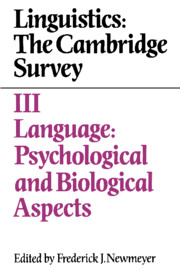Book contents
- Frontmatter
- Contents
- Contributors
- Preface
- 1 Psycholinguistics: an overview
- 2 Language and cognition
- 3 Processes in language production
- 4 Language perception
- 5 The mental lexicon
- 6 Where learning begins: initial representations for language learning
- 7 Second language acquisition
- 8 Neurolinguistics: an overview of language–brain relations in aphasia
- 9 The biological basis for language
- 10 Linguistics and speech–language pathology
- 11 The evolution of human communicative behavior
- 12 Linguistics and animal communication
- Index of names
- Index of subjects
- Contents of Volumes I, II, and IV
3 - Processes in language production
Published online by Cambridge University Press: 03 February 2010
- Frontmatter
- Contents
- Contributors
- Preface
- 1 Psycholinguistics: an overview
- 2 Language and cognition
- 3 Processes in language production
- 4 Language perception
- 5 The mental lexicon
- 6 Where learning begins: initial representations for language learning
- 7 Second language acquisition
- 8 Neurolinguistics: an overview of language–brain relations in aphasia
- 9 The biological basis for language
- 10 Linguistics and speech–language pathology
- 11 The evolution of human communicative behavior
- 12 Linguistics and animal communication
- Index of names
- Index of subjects
- Contents of Volumes I, II, and IV
Summary
Introduction
A number of years ago, the distinguished psychologist Charles Osgood became interested in the problem of language production (1971). He held the view that the study of production processes was the natural arena for exploring fundamental relations between cognitive structure and language forms. From his perspective, the focus of interest was the intention of speakers to achieve particular semantic and pragmatic consequence; those intentions drove, more or less directly, syntactic and lexical selection, and hence were the proper domain of study for the analysis of real-time sentence planning activities.
He began his inquiry by asking what variation in language form was associated with changes of perspective and presupposition in a simple descriptive task. So, for example, he asked what perceptual and cognitive conditions would demonstrably trigger a shift from active to passive voice, what would trigger the use of a definite article, or the contrastive use of a modifier. And he was able to effect such changes by systematic alteration of the conditions in his scene description task.
In this case, as in many others, Osgood was ahead of his time. Description, of language-particular processes was not then well developed, nor were there accessible characterizations of the conceptual-level semantic structures that interact with language structures to yield connected discourse. The experimental results he attained were, thus, not readily connected to formal linguistic and logical systems, and the theory of language-particular processes was only nascent.
These problems are not solved at present, but the outlines of solutions have begun to emerge, and there are prospects for the serious pursuit of the goals Osgood avowed.
- Type
- Chapter
- Information
- Linguistics: The Cambridge Survey , pp. 69 - 96Publisher: Cambridge University PressPrint publication year: 1988
- 106
- Cited by

